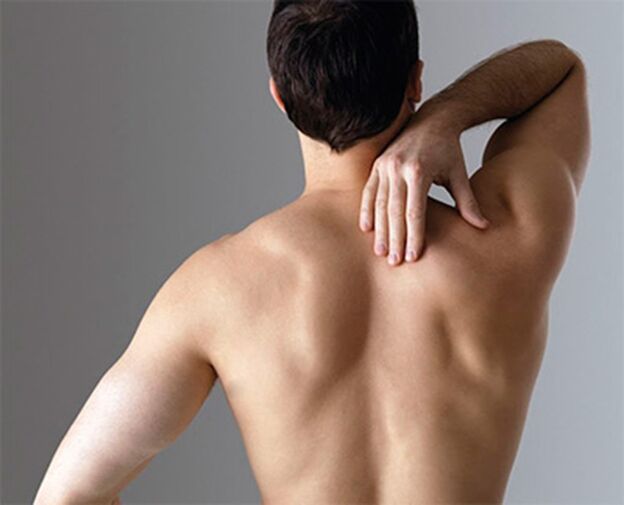
Back pain in the shoulder blade area is a characteristic symptom not only of diseases of the spine, but also of pathologies of internal organs. Why is it necessary to consult a doctor and with which specialist to make an appointment? Effective methods of getting rid of discomfort.
If you are worried about back pain in the area of the shoulder blades, such a symptom may indicate diseases of the spine or shoulder girdle, nerve pathology, somatic diseases. Careful collection of patient histories and complaints allows you to identify the cause of the problem and decide on further treatment.
Often, back pain in the shoulder blade area is the first sign of pathological changes in the body. And the definition of the provoking factor allows you to prevent the exacerbation of the disease at an early stage. The symptom can occur in one half of the body or spread to the arm, appear during inhalation - all this is important when making a diagnosis.
The causes of pain and its localization
As a rule, discomfort appears in the shoulder blade area when moving. For example, a prolonged static position of the body, an uncomfortable turn. In this case, the pain under the shoulder blade signals damage.
Important!Unilateral localization of pain (to the left under the shoulder blade or to the right) is rare. This is due to the symmetrical arrangement of the nerve roots of the spinal cord.
Traumatic injury
Painful sensations can signal muscle or bone damage. In this case the symptom is widespread and of variable intensity. The pain arises sharply and persists.
Injuries that can cause shoulder blade pain:
- Fractures, cracks. A severe injury where pain is concentrated directly in the shoulder blade. The symptom is aggravated with minimal movement, so the patient cannot move.
- bruises. The discomfort is superficial, occurs due to damage to the muscle structure and is localized in the lower part of the shoulder blades. On examination, it is possible to detect signs of inflammation, swelling of the tissues. Symptoms persist for 14-21 days.
- Subluxation or displacement of the vertebrae. Joint pain occurs under the shoulder blades or at their level. Discomfort can be exacerbated by compression of the nerve roots.
With injuries in the area of damage, soft tissue edema is observed, pain appears suddenly. A creak often appears when moving.
Spinal protrusion and herniation
With this pathology, the spinal cord and nerve roots are compressed, which is accompanied by reduced sensitivity and sharp pain under the right and left shoulder blades.
Possible placement of discomfort:
- Back pain under the shoulder blade on the left or right. It indicates a lesion of 6-12 discs with possible involvement of the lumbar spine in the pathological process. Since the latter is subject to greater stress, there is a high risk of developing spinal hernias.
- Above the shoulder blades. The protrusion is localized in the cervical spine or in segment 1-3. The discomfort becomes more pronounced with the movement of the head.
- Between the shoulder blades. Pain is observed when 3-6 segments of the spine are affected. It becomes more pronounced with a deep breath, rotating the body, abducting the upper limbs to the sides.
Note!With protrusion, the pain persists even at rest. This is due to compression of the nerve roots and muscle spasm.
Osteochondrosis
If the back hurts in the area of the shoulder blades, the symptom may indicate osteochondrosis of the thoracic spine. The symptom occurs due to entrapment of the spinal cord or nerve roots and deformation of the intervertebral disc. The disease progresses gradually, causing increasingly vivid symptoms.
The area of discomfort is determined by the location of the lesion:
- 2-6 segments. The discomfort is localized at the level of the shoulder blades, irradiation to the arm and neck is possible. An increase in intracranial pressure, dizziness due to squeezing of blood vessels is possible.
- 6-12 segments. There is pain under the shoulder blade on the left or right back and extends to the lower back.
Note!With osteochondrosis, the pain is one-sided.
Spondyloarthrosis
This pathology is also characterized by the unilateral placement of the pain syndrome. With spondylarthrosis, there is a violation of mobility, a feeling of stiffness due to damage to the intervertebral discs and facet joints.
Symptoms depend on the neglect of pathological changes:
- Destruction of cartilage tissue. It develops against the background of impaired blood circulation and a violation of the integrity of the connective tissue. The cartilage element becomes fragile, quickly damaged and slowly renewed. The situation is aggravated by microtraumas due to intense physical exertion. In this case, the pain radiates to the shoulder blades and lower back.
- Deformation of the intervertebral disc. Thickening of the tissue is accompanied by reduced mobility, as well as pain in the shoulder blades and back. In this context, the destructive processes are intensifying.
- The formation of bone growths. They appear in the advanced form of spondylarthrosis. They lead to damage to blood vessels, muscle tissues, nerves, joints.
With spondylarthrosis, pain occurs after physical exertion and can be localized in the area of the shoulder blades or between them. At rest, the symptom disappears.
Scoliosis
It is accompanied by a curvature of the spine in a transverse direction due to the tension of the muscles that support the posture. In this case, the spinal cord and nerves are compressed, discomfort is observed under the shoulder blade.
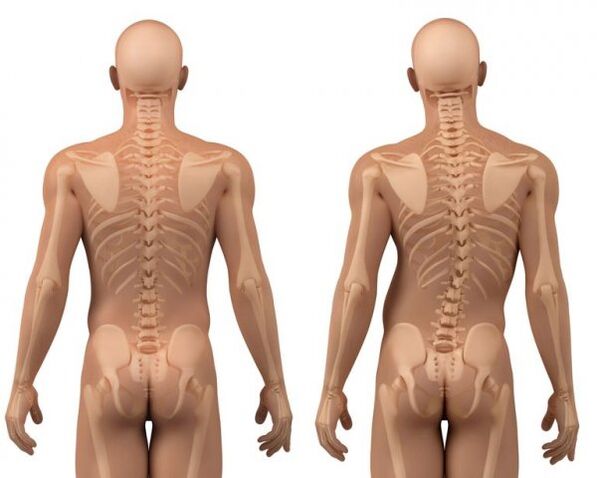
Other symptoms of scoliosis:
- Chest deformation. There is a displacement of the ribs and vertebrae, which leads to damage to the spinal cord and its branches. For this reason, back pain is observed on the left under the shoulder blade or on the right.
- Respiratory disturbance. Due to the deformation of the chest, dysfunction of the lungs is observed: one of them is compressed, the second is trying to compensate for the gas exchange deficit.
- Violation of cardiac activity. Due to the tilted spine, shortness of breath is present, the skin becomes pale, the heart rate changes.
Note!Scoliosis is characterized by compression of the spinal cord, so the discomfort is localized between the shoulder blades or under them. The pathological focus has clear contours and can spread to neighboring areas only with muscle spasms.
kyphosis
Kyphosis is a backward curvature of the spine, in which the shoulder girdle is pulled forward, a curvature appears. In this case, the pain is localized above the shoulder blades, is bilateral in nature, radiates to the neck, arm.
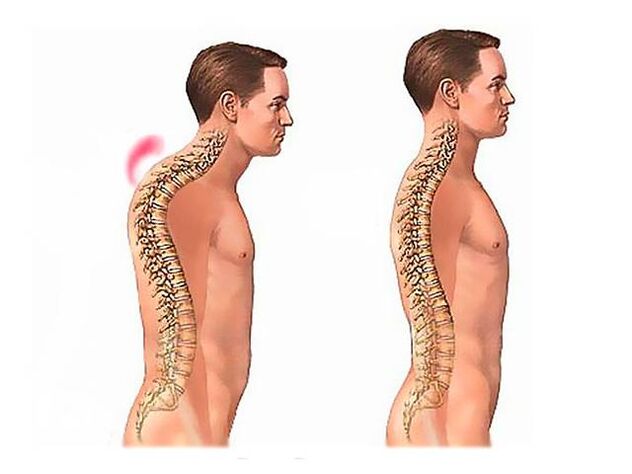
Mechanisms of pain formation in kyphosis:
- Muscular. The curvature of the spine leads to an overload of the muscles of the collar area and their spasm, which is accompanied by pain in the shoulder blades.
- Neurogen. Against the background of the curvature of the spine, the distance between the vertebrae decreases. This leads to the violation of the branches of the spinal cord and the occurrence of pain in the area of the shoulder blades, which can spread to the neck, collarbone, shoulder.
With kyphosis, the vertebral artery is compressed, which leads to a deterioration of cerebral circulation, dysfunction of internal organs.
Radiculitis
The pathology is characterized by pinching of the lumbar roots that form the sciatic nerve. With the defeat of the upper section, the pain is localized under the shoulder blade and below. The discomfort is bilateral, it becomes more pronounced with sudden movements.
If left untreated, sciatica is accompanied by other symptoms:
- burning pain in the back (under the shoulder blades and in the lower back) - indicates pinching of the spinal roots;
- low back pain with irradiation to the leg;
- convulsions;
- violation of sensitivity in the buttocks, lower back;
- numbness along the nerve (can be observed in the lower leg, thigh, foot).
Neuralgia
Inflammation of the nerve fibers in this anatomical region can cause pain under the shoulder blades. A common cause of pathology is hypothermia.
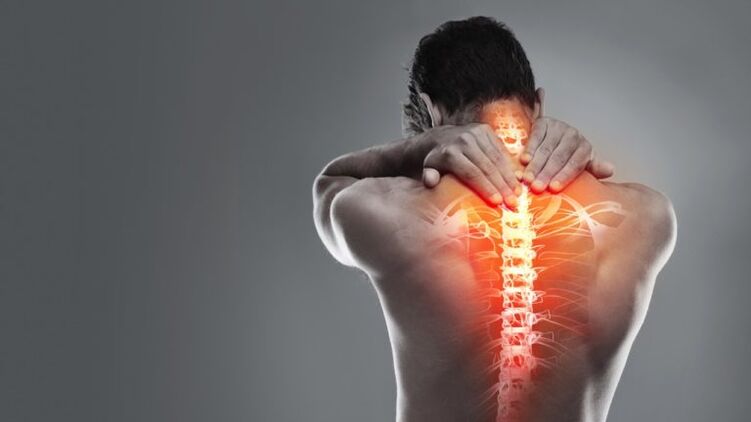
Inflammation can affect structures such as:
- Intercostal nerves. 1-4 pairs located along the lower edge of the ribs are affected. The pain is localized under the shoulder blades and below, in the lateral parts of the chest, less often it extends to its anterior sections.
- Supraspinatus and suprascapular nerves. Characterized by the appearance of pain in the shoulder blade area from the back in the collarbone area. Sometimes the symptom extends to the shoulders.
- The infraspinatus and subscapularis nerves. The discomfort is felt under the shoulder blade on the left or right. When the inflammation spreads to the muscles, the pain increases when you move your hands.
Note!With neuralgia, the pain is often of a one-sided nature: the symptom is localized in the part that has suffered hypothermia.
Shoulder-scapular periarthrosis
It is characterized by inflammation of the shoulder joint and surrounding tissues. It is accompanied by reduced mobility, which can only be removed after warming up the muscles.
With humeroscapular periarthrosis, discomfort is observed in the shoulder blades and below. In the initial stage, it occurs after intense physical activity, as the disease progresses, at rest. Other symptoms of pathology:
- numbness of the upper limbs;
- headache;
- reduced mobility of the spine.
heart pathology
Pain under the shoulder blades can indicate heart disease. This is due to the fact that the parasympathetic trunk branches connected to the spinal cord and nerve roots go to the organ. If there is pain under the left shoulder blade from behind from the back, the symptom may indicate a mild form of myocardial infarction. It can persist for several days, increase with movement and decrease at rest.
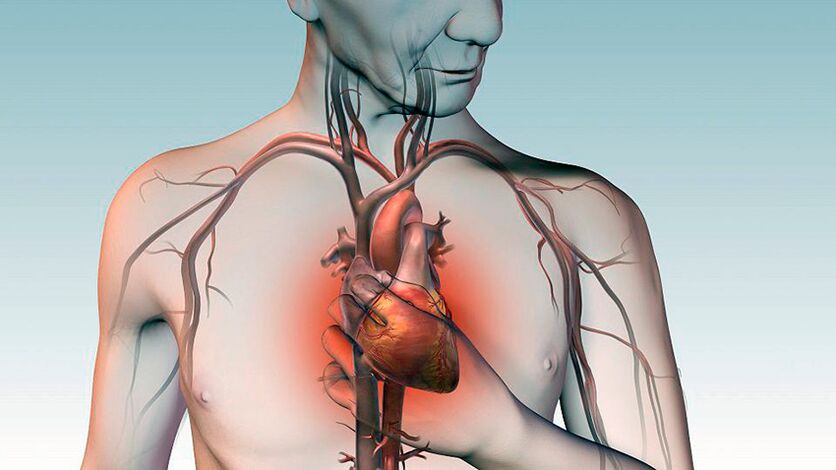
Other signs of pathology:
- burning, pressing pain behind the breastbone;
- heart rhythm disturbance;
- palpitations;
- dyspnea;
- dizziness;
- nausea;
- increased blood pressure.
Diseases of the digestive system
The mechanism of the onset of pain is similar to the previous reason - spread along the nerve fibers. The localization of the symptom depends on the affected organ, less often the discomfort is bilateral.
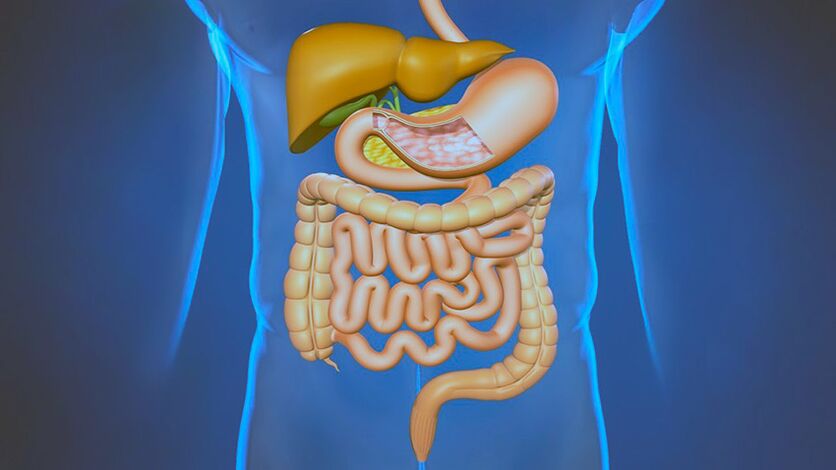
If the back hurts to the left under the shoulder blade, development is possible:
- inflammation of the gastric mucosa;
- pancreatitis (inflammation of the pancreas);
- stomach ulcer.
Also, with such pathologies, there is nausea, vomiting, heartburn, belching, heaviness in the abdomen. If the ulcer is complicated by internal bleeding, there is paleness of the skin, a decrease in blood pressure, weakness, darkening of the stool.
A feeling of discomfort under the right shoulder blade can indicate such ailments:
- duodenal ulcer;
- hepatitis;
- cirrhosis of the liver;
- cholelithiasis.
Other causes of the symptom
The following factors can also provoke pain in the shoulder blade area:
- Uncomfortable sleeping place. In particular, a collapsed mattress and sleeping on the left side can cause pain on the opposite side, as the spine bends and the roots are pinched.
- Vegetovascular dystonia. It is accompanied by drops in blood pressure, shortness of breath, reduced heart activity, and sometimes back pain in the shoulder blade area.
- Polio. An infectious disease in which shoulder blade pain is neurogenic.
- Pleurisy. With inflammation of the pleura, the symptom occurs due to the friction of its sheets against each other. The peak of pain occurs with a deep breath.
- Renal pathology. Characterized by shooting and stabbing pain under the right shoulder blade. In addition, there is a change in the color of urine, in the production of urine.
- Intoxication. Discomfort occurs when an excess of toxins or decomposition products accumulate in the body against the background of a cold or due to severe poisoning. It is accompanied by chills, body aches, fever.
- Subphrenic abscess. Pain under the shoulder blades is observed when inhaling, it arises from the accumulation of pus in the upper abdominal cavity.
- Mental disorders. Sometimes mental disorders are accompanied by discomfort in the back, but the mechanism of its development has not yet been studied.
Types of pain
The nature of the pain in the shoulder blade area can be different. Depending on this criterion, it is possible to hypothesize a possible disease and determine the cause of the discomfort:
- Shot, sharp, which rises when you turn your body or move. Typical for pinched nerves. This feature allows you to distinguish it from pain in gallstone disease: with this diagnosis, the discomfort is constant and does not depend on movements.
- Cutting, boring pain of varying intensity. It can indicate neuralgia, joint inflammation.
- Throbbing, aching or burning. Such pain in the area of the shoulder blades indicates diseases of the internal organs. The symptom develops due to compression of the nerve roots, with movement it can become more pronounced.
- Choking pain in the shoulder blades or below. Typical for a herniated spine. Often accompanied by numbness in the arms or legs, low back pain.
Which doctor should I go to?
If painful sensations appear in the area of the shoulder blades, you should make an appointment with a neurologist. The doctor will conduct an examination, establish a diagnosis and determine treatment tactics. In case of detection of pathologies of the internal organs, he will refer to a specialist with a narrow profile: a gastroenterologist, a cardiologist, an orthopedist (depending on the alleged diagnosis).
Poll
To establish the cause of the onset of pain in the area of the shoulder blades, patients are assigned the following diagnostic procedures:
- Clinical studies on blood, urine. They show inflammatory changes, help in the diagnosis of somatic diseases.
- X-ray examination, CT. They allow you to detect the curvature of the spine, injuries and their consequences, osteochondrosis.
- Ultrasound. It is used to identify pathologies of internal organs.
- ECG. Information in case of suspected heart disease.
- magnetic resonance. It reflects the condition of the spine, shoulder girdle, internal organs. The investigation area is determined by the doctor based on the proposed diagnosis.
Note!Pain under the shoulder blades is often indicative of neurological abnormalities. Therefore, CT and MRI are the "gold standard" in determining the cause of a symptom.
Characteristics of the treatment
The goal of treatment is not only to remove the pain, but also to eliminate the factor that leads to its appearance. When seeking medical help, the pain syndrome is alleviated in parallel, as well as the appointment of etiological treatment aimed at eliminating the underlying disease.
The therapeutic program may include the following methods:
- Medical treatment. To relieve pain, drugs from a number of analgesics and anti-inflammatory drugs are used. Depending on the cause of the symptom, antibacterial agents, diuretics, gastroprotectors, etc. can be used.
- Physiotherapy. Helps accelerate recovery from somatic pathologies, strengthen the spine. To eliminate pain in the shoulder blade area, electrophoresis, UHT and warming procedures are used.
- Massage. Helps to remove muscle spasms, improve posture, relieve painful sensations. It is prescribed for spinal problems. Sometimes the intervention of an osteopath or a chiropractor is necessary.
- Gym. Shown during the recovery period. A set of exercises is selected individually for each patient, depending on the established diagnosis.
How to prevent discomfort in the shoulder blade area?
Each patient who has undergone a course of treatment is subsequently recommended to follow a series of preventive measures. They are necessary to prevent the recurrence of the disease.
It is important to follow these rules:
- create favorable conditions for sleep - choose an orthopedic pillow and a mattress of moderate firmness to support the physiological position of the spine;
- watch your posture;
- follow the principles of proper nutrition;
- try to prevent the exacerbation of chronic pathologies;
- giving up addictions (smoking, drinking alcohol);
- Visit your doctor regularly for preventive examinations.
Shoulder blade pain can be caused by somatic and neurological causes. In the latter case, the symptom manifests itself sharply and is pronounced. Of somatic origin, the pain gradually increases and persists for a long time, it does not depend on the movements of the body.
Analgesics can be used to relieve an unpleasant symptom. However, in order to completely get rid of pain sensations, it is important to undergo a full course of treatment aimed at eliminating the underlying pathology. Only a doctor can develop the correct therapeutic course after a comprehensive examination.




































